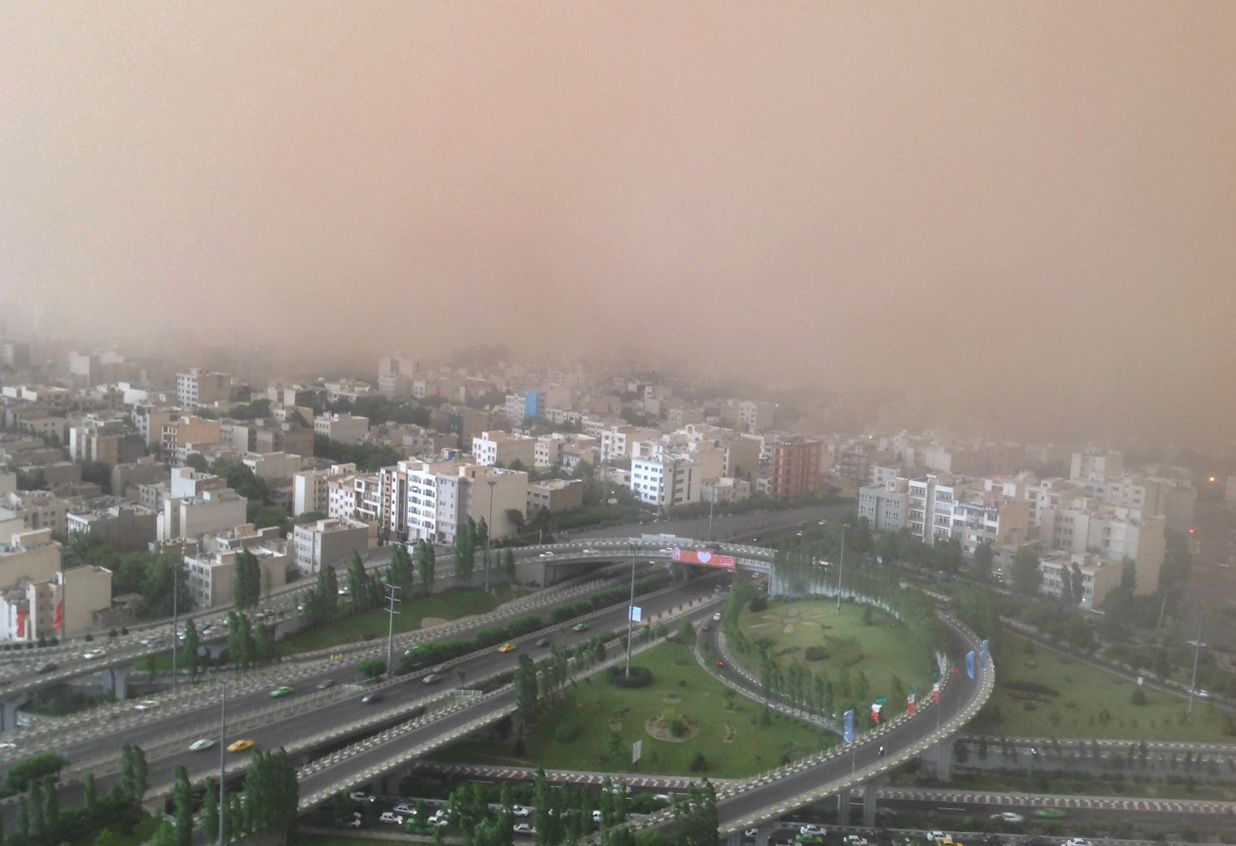For the past 10 years, Iran has been struggling with sand and dust storms that originate from sources both inside and outside the country.
Experts agree that domestic and foreign sources are to blame for the intense storms that batter large swathes of the country every year.
In Iran, dried up wetlands such as Hoor al-Azim and Shadegan in the southwest as well as Jazmourian and the Hamouns in the southeast are among the major sources of dust.
A significant amount of the dirt comes from sources that lie outside Iran's borders, mainly in the desiccated plains of Iraq and Syria. What the experts cannot seem to agree on is which sources are responsible for the bulk of the storm that blankets numerous Iranian cities.
In late February, Khodakaram Jalali, the head of Iran's Forests, Range and Watershed Management Organization, told the media that 80% of the dust and sand emissions in Khuzestan Province originate from beyond Iran's borders.
This is while Reza Shahbazi, director of the project to fight dust storms at the Geological Survey of Iran, insists that currently the share of foreign sources has declined drastically.
"In fact, roughly 80% of the particles come from domestic sources," he told Financial Tribune on the phone.
Shahbazi explained that the statistics cannot be generalized and describe the trends at specific times of the year.
"Each of the sources can dominate at certain times and the figure announced by me [80%] refers to the early February storms in Khuzestan," he said.
However, the official asserted that the impact of external sources is more prominent throughout the year, which is what Jalali was referring to when he said 80% of dust storms originate overseas.
Shahbazi added that based on a recent decision by the National Committee for Combating Dust Storms, "related entities will report the same figures starting next Iranian year [begins March 21] to avoid any contradictory information".
Made Worse by Us
The first massive storm in Iran erupted in the summer of 2009, lashing Khuzestan and other southwestern provinces as well as Tehran and central provinces. While dust particles do not normally rise above two kilometers, the 2009 storm crossed over the Alborz Mountain Range and reached the northern provinces of Gilan and Mazandaran as well.
The following year, a more severe storm started in spring and almost covered the entire country. Since then, the phenomenon has been recurring on a yearly basis but mostly affecting the southwestern provinces, particularly Khuzestan.
Persistent drought and desiccation of wetlands and rivers have made an otherwise natural phenomenon worse. While global warming is partly to blame for this, human interference has turned dust storms into a problem of epic proportions.
Unrestrained dam construction, excessive withdrawal of groundwater, deforestation and even oil exploration (in the case of Hoor al-Azim at least) have all contributed to the deterioration of the situation.
Reforestation, mulching and revival of wetlands and rivers are among measures employed by the authorities to tackle storms sourced in Iran.
The government has allocated $100 million to implement key projects in the next year's budget bill. Nonetheless, experts believe the amount is about a quarter of what is needed to effectively address the issue.
A Regional Problem
While financial constraints impede domestic measures, regional conflicts disturb international cooperation that is crucial for removing the foreign sources of dust storms.
Iraq, Syria, Saudi Arabia and the UAE in the west and south of Iran are home to major sources of sand and dust storms, while hotspots in Afghanistan contribute to storms formed in the east.
Turkey does not have hotspots but has significantly contributed to the formation of dust sources in Iraq and Syria through unrestrained dam construction under the Southeastern Anatolia Project, also known as the GAP development project.
According to Ziaeddin Shoaei, an Iranian environment official who leads the national campaign against dust storms, GAP has led to the desiccation of 94% of the Mesopotamian region (in Iraq) and a 37% reduction in the water flowing from Tigris and Euphrates rivers.
Iran never directly negotiated with Turkey but has urged international organizations to impose a ban on projects like GAP. According to Energy Minister Hamid Chitchian, the storage of more than 100 billion cubic meters of water in lakes in central Iraq, at the expense of other wetlands in the country, has turned Iran's western neighbor into the most prominent source of dust emissions.
As a result of discussions with Iraqi authorities in 2012, an agreement was reached based on which saplings would be planted across 200 hectares of plains surrounding Karbala. The plan has not yet been implemented after about five years because the country has been embroiled in an all-out war against the self-styled Islamic State terrorist group.
In a last-ditch attempt to garner international support, Iran has proposed and pursued the issuance of four UN-backed resolutions. The first and second resolutions were approved in the UN General Assembly and involved the preparation of a global evaluation report and the technical and financial assistance of international communities such as the World Bank, the Convention to Combat Desertification and World Meteorological Organization.
The third resolution approved by the UN headquarters in Bangkok, Thailand, stresses regional cooperation and the fourth one issued by the UN headquarters in Nairobi, Kenya, compels regional and international development banks such as the Asian and Islamic development banks to provide the financial means to address the issue.
Iran is also hosting an international conference next year in which representatives from more than 50 countries are expected to discuss dust storms and take decisive action to mitigate its impacts.
Massoumeh Ebtekar, the head of Iran's Department of Environment, and Foreign Minister Mohammad Javad Zarif recently sent a joint letter to UN Secretary-General Antonio Guterres, urging the global community to convince regional countries to collaborate with Iran in this regard.



